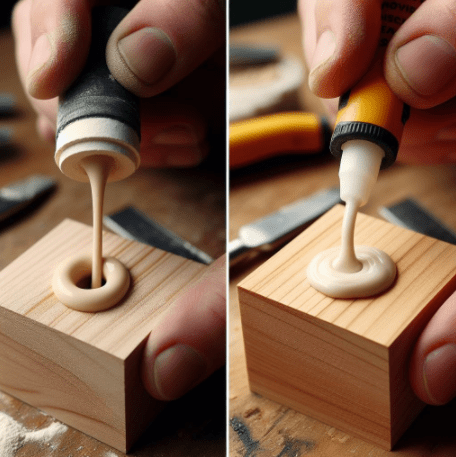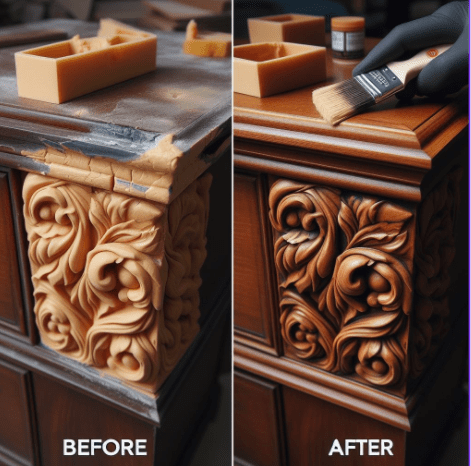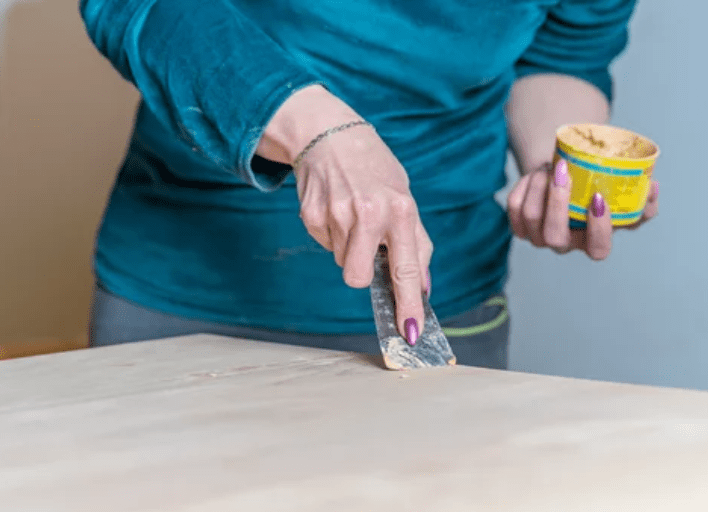
An age-old question stumped woodworkers and DIY enthusiasts alike for generations: “Wood Putty vs. Wood Filler: What’s the Difference?” Knowing the distinction between these two similar yet distinct wood products is vital to mastering the art of wood repair and restoration.
Getting Down to the Grain: An Introduction to Wood Putty and Wood Filler
The confusion between wood putty and wood filler isn’t without reason. At first glance, they seem almost identical. Both come in small tubs, are used for repairing wood, and are easy to apply. Yet, the devil’s in the details. Underneath these superficial similarities, significant differences influence their best use cases.
Understanding Wood Putty
What Makes Up Wood Putty?
Wood putty, or plastic wood, is a dough-like material typically made from boiled linseed oil, calcium carbonate, and universal colorants. Some putties also incorporate fine wood dust for a more natural blend with the wood surface.
Where is Wood Putty Best Used?
Wood putty is ideal for outdoor applications due to its slower drying time and superior flexibility. It’s a champ at withstanding harsh weather conditions. It’s commonly used for patching up nail holes and minor wood blemishes on outdoor furniture, decks, and fences.
Digging Deeper: The Characteristics of Wood Filler
Wood Filler’s Composition
Wood filler, alternatively known as wood grain filler, usually comprises sawdust or wood fibers mixed with a binding agent. This substance dries hard and fast, creating a solid bond that can be sanded, stained, and painted like natural wood.
When to Use Wood Putty vs. Wood Filler: Practical Examples

Choosing between wood putty and wood filler comes down to your specific project. Here are some common scenarios to help you decide:”
-
- Filling nail holes in finished furniture: Wood putty is ideal as it won’t shrink and can be matched to the existing finish.
- Repairing a small chip in painted baseboards: Wood putty offers a quick fix without sanding or staining.
- Fixing a larger gouge in unfinished wood: Wood filler is better, as it will harden and can be sanded and stained to blend seamlessly.
- Patching an outdoor deck crack: Wood putty’s flexibility makes it more weather-resistant for this exterior job.
Wood Putty vs. Wood Filler: What’s the Difference?
Wood putty and wood filler serve the same fundamental purpose: repairing and restoring wood. However, their composition, drying times, applications, and flexibility differ. Knowing when to use each one is invaluable for any DIY enthusiast or woodworking professional.
Comparison Table: Wood Putty vs. Wood Filler
| Characteristic | Wood Putty | Wood Filler |
|---|---|---|
| Composition | Linseed oil, calcium carbonate, colorants, and sometimes wood dust | Sawdust or wood fibers, binding agent |
| Drying Time | Slow | Fast |
| Best Use Case | Outdoor wood repairs | Indoor wood repairs |
| Flexibility | High | Low |

Frequently Asked Questions about Wood Putty and Wood Filler
Q: Can I use wood putty and wood filler interchangeably?
A: Wood putty and filler can repair wood, but they are best used in different scenarios due to their unique properties. Using them interchangeably might not yield the desired results.
Q: Can wood filler be stained and painted?
A: Yes, once it dries, the wood filler can be sanded, stained, and painted just like regular wood.
Q: Is wood putty weather-resistant?
A: Absolutely! Wood putty is well-suited for outdoor applications thanks to its weather-resistant properties.
Q: Does wood filler dry hard?
A: Wood filler dries hard and fast, so it’s excellent for interior wood repairs.
Q: Which is more flexible: wood putty or wood filler?
A: Wood putty wins the flexibility contest due to its slower drying time and oil-based composition.
Q: Can I make my wood filler?
A: Indeed, you can. Homemade wood filler often involves mixing sawdust from the same wood you’re repairing with a binding agent like a carpenter’s glue.

50 Facts People Ask Also
1. Best wood putty: The “best” is subjective, depending on your specific project needs. Brands like Minwax and Elmer’s are often lauded for their excellent quality and reliability.
2. Wood putty for floors: Choose a durable and stainable wood putty for floor repairs. This ensures that the restorations blend seamlessly with the rest of the flooring.
3. Wood putty outdoor use: Wood putty excels in outdoor applications thanks to its weather-resistant properties. It’s perfect for repairing garden furniture, fences, and decks.
4. Elmer’s wood putty: Elmer’s is a trusted brand in the world of wood putty. Their products are renowned for their easy application and excellent sanding properties.
5. Minwax wood putty: Minwax wood putty is another top choice among woodworkers. Their range includes various colors to match different wood types.
6. How to use wood putty: Wood putty is easy to apply. Clean the damaged area, apply the putty, then allow it to dry before sanding for a smooth finish.
7. Wood putty vs. spackle: Spackle is typically used for repairing plaster or drywall, while wood putty is used to improve wood.
8. Wood putty for decks: Decks often require sturdy, weather-resistant wood putty. The putty should also match the color of the deck for aesthetic purposes.
9. DAP wood putty: DAP offers a variety of wood putty products, popular for their strength and durability.
10. White wood putty: White wood putty is ideal for fixing imperfections in white or light-colored wood surfaces.
11. Wood putty before or after staining: Typically, wood putty is applied after staining. This way, you can match the putty color to the stain.
12. Wood putty or wood filler for floors: Both can be used for floor repairs, but wood filler is usually preferred for its hardness and fast-drying properties.
13. Sandable wood putty: Sandable wood putty allows for a smooth finish. Once dry, it can be sanded down to blend seamlessly with the surrounding wood.
14. Wood putty for hardwood floors: Hardwood floors require a high-quality wood putty that matches the color and texture of the wood.
15. Epoxy wood putty: Epoxy wood putty is a two-part system that offers excellent durability. It’s perfect for heavy-duty repairs.
16. How to apply wood putty: Apply wood putty using a putty knife, press it into the damaged area, then smooth it over. Allow it to dry before sanding.
17. Wood putty for doors: Doors often suffer from dents and scratches. Wood putty can effectively fill these imperfections for a rejuvenated look.
18. How to make wood putty: Homemade wood putty can be made by mixing sawdust from the same wood you’re repairing with a binder like carpenter’s glue.
19. Wood putty drying time: Wood putty drying times can vary depending on the brand and type, but it typically takes several hours.
20. Stainable wood putty: Stainable wood putty can be stained to match the color of your wood, making it perfect for invisible repairs.
21. Paintable wood putty: Paintable wood putty allows you to cover the repaired area with paint for a seamless finish.
22. Wood putty colors: Wood putty comes in a variety of colors to match different types of wood, from oak and walnut to pine and cherry.
23. Wood putty for screw holes: Wood putty is excellent for filling screw holes, making them almost invisible.
24. Exterior wood putty: Exterior wood putty is designed to withstand outdoor conditions. It’s weather-resistant and ideal for repairs on outdoor furniture and structures.
25. Interior wood putty: Interior wood putty is typically used for indoor repairs, like fixing furniture, doors, and floorboards.
26. Wood putty for furniture: Wood putty is perfect for repairing furniture. It can fill scratches, dents, and gouges to restore your furniture’s pristine look.
27. Wood putty temperature range: Wood putty should ideally be applied in moderate temperatures. Too hot or too cold conditions can affect its performance.
28. Wood putty for trim: Wood putty can be used to fill holes or cracks in trim work before painting or staining for a flawless finish.
29. Acrylic wood putty: Acrylic wood putty is water-based, making it easy to clean up. It’s often used for light-duty repairs.
30. Wood putty vs wood patch: Wood patch is a type of wood filler typically used for larger repairs. Wood putty, however, is more suitable for small imperfections.
31. Water based wood putty: Water-based wood putty is easy to apply and clean. However, it’s not as durable as oil-based putty and is best for indoor use.
32. Oil based wood putty: Oil-based wood putty is durable and flexible, making it great for exterior applications where weather resistance is needed.
33. Wood putty for nail holes: Nail holes can be seamlessly filled using wood putty. Once dry, the repaired area can be painted or stained to match the surrounding wood.
34. LePage’s wood putty: LePage is a reputable brand offering a range of wood putty products known for their easy application and solid performance.
35. Wood putty for pressure-treated wood: Pressure-treated wood can also be repaired with wood putty, but choose a putty rated for exterior use.
36. Non-shrinking wood putty: It doesn’t contract as it dries, ensuring the repaired area remains flush with the surrounding wood.
37. Waterproof wood putty: Waterproof wood putty is ideal for outdoor applications where the wood is exposed to moisture.
38. Wood putty for kitchen cabinets: Choose a durable wood putty that can withstand frequent use and cleaning.
39. Quick drying wood putty: Quick-drying wood putty is great for speedy repairs. However, work quickly as it can become hard to manipulate as it starts drying.
40. Wood putty for cracks: Wood putty can fill small to medium-sized cracks in wood. You might need a more substantial wood filler or patch for larger cracks.
41. Wood putty for gaps: Wood putty can effectively fill small gaps in wood. However, for larger gaps, a dedicated gap filler might be needed.
42. Wood putty for veneer: Veneer repairs require a fine, high-quality wood putty that can be smoothed out for a seamless finish.
43. Natural wood putty: Natural wood putty doesn’t contain any added color, allowing you to stain or paint it to match your wood exactly.
44. Wood putty for cedar: Choose a cedar-colored wood or a natural putty that can be stained to match.
45. Wood putty for pine: Pine-colored wood putty is perfect for repairing pine furniture or structures.
46. Walnut wood putty: Walnut wood putty matches the rich, dark color of walnut wood, making it perfect for repairing walnut furniture or floors.
47. Wood putty for oak: Oak-colored wood putty blends seamlessly with oak wood. It’s ideal for repairing oak furniture or flooring.
48. Cherry wood putty: Cherry wood putty is designed to match the reddish color of cherry wood, perfect for seamless repairs.
49. Flexible wood putty: Flexible wood putty retains some elasticity even when dry, making it suitable for areas that experience movement or stress.
50. Colored wood putty: Colored wood putty is available in various shades to match different wood types and finishes.
Wood Putty vs. Wood Filler: Quick Decision Guide
-
- For finished wood and small repairs, Choose wood putty.
- For unfinished wood and larger repairs, Choose wood filler.
- For outdoor projects: Wood putty is generally more flexible and weather-resistant.
- When matching the finish matters: Wood putty can be painted or stained.
With this knowledge in your toolbox, you’re ready to tackle your wood repair projects like a pro!

























